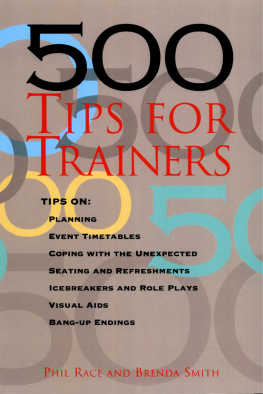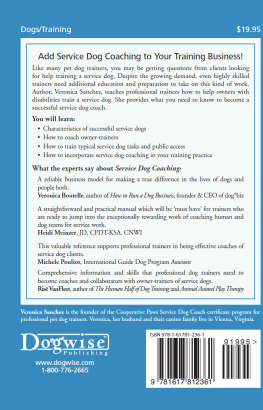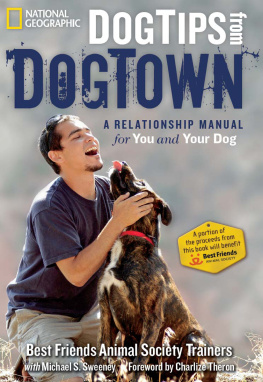Race Philip - 500 Tips for Trainers
Here you can read online Race Philip - 500 Tips for Trainers full text of the book (entire story) in english for free. Download pdf and epub, get meaning, cover and reviews about this ebook. year: 2011, publisher: Taylor & Francis (CAM);Elsevier Science & Technology, genre: Home and family. Description of the work, (preface) as well as reviews are available. Best literature library LitArk.com created for fans of good reading and offers a wide selection of genres:
Romance novel
Science fiction
Adventure
Detective
Science
History
Home and family
Prose
Art
Politics
Computer
Non-fiction
Religion
Business
Children
Humor
Choose a favorite category and find really read worthwhile books. Enjoy immersion in the world of imagination, feel the emotions of the characters or learn something new for yourself, make an fascinating discovery.
- Book:500 Tips for Trainers
- Author:
- Publisher:Taylor & Francis (CAM);Elsevier Science & Technology
- Genre:
- Year:2011
- Rating:4 / 5
- Favourites:Add to favourites
- Your mark:
- 80
- 1
- 2
- 3
- 4
- 5
500 Tips for Trainers: summary, description and annotation
We offer to read an annotation, description, summary or preface (depends on what the author of the book "500 Tips for Trainers" wrote himself). If you haven't found the necessary information about the book — write in the comments, we will try to find it.
500 Tips for Trainers — read online for free the complete book (whole text) full work
Below is the text of the book, divided by pages. System saving the place of the last page read, allows you to conveniently read the book "500 Tips for Trainers" online for free, without having to search again every time where you left off. Put a bookmark, and you can go to the page where you finished reading at any time.
Font size:
Interval:
Bookmark:

Copyright 1996 by Phil Race and Brenda Smith.
First published in 1995 by Kogan Page Ltd., 120 Pentonville
Road, London, N19JN. This edition published in North
America by Gulf Publishing Company in 1996.
All rights reserved. This book, or parts thereof, may not be reproduced in any form without
permission of the publisher.
Gulf Publishing Company
Book Division
P.O. Box 2608  Houston, Texas 77252-2608
Houston, Texas 77252-2608
10 9 8 7 6 5 4
Printed on Acid-Free Paper ()
Library of Congress Cataloging-in-Publication Data
Race, Philip.
500 tips for trainers / Phil Race and Brenda Smith, p. cm.
p. cm.
First published in 1995 by Kogan Page ... London
T.p. verso.
Includes bibliographical references and index.
ISBN 0-88415-288-X
1. EmployeesTraining of. I. Smith, Brenda. II Title.
HF5549.5.T7R23 1996
658.3124dc20 95-43405
Transferred to Digital Printing 2006 CIP
We've written this book for busy people! We know that if you're a busy trainer, you probably won't have much time (or appetite) for the sort of book which offers profound and deep theories of how people learn at training sessions, or complex pedagogical models of how we should try to structure our training. In this book we've tried to offer down-to-earth, practical suggestions.
We've designed this book as a resource to be sampled. We don't expect anyone to read it cover to cover. We've tried to build in a sort of logic, with planning towards the start of the book and evaluating towards the end, but many of the sets of suggestions could have been placed in different chapters and in a different sequence, so don't regard the order of presentation of our suggestions as definitive!
On the whole, we've presented ten tips on each of 50 topics (except that a couple of times we got over-enthusiastic and ended up with 20, even 22, tips instead of ten!). At the start of each collection of tips, we've added a line or two to help you see what the suggestions are really about; we hope these introductions will help you to decide which sets of tips to have a look atand which to skip or save for later!
We're quite sure that when you look at some of our suggestions you'll say to yourself, Yes, but I already do this! This is, of course, fine. Our main hope is that you'll also find something that makes you say to yourself, Ah, I've never tried thatI may be able to give it a go in my next session.
We'd like to have your reactions to our book. We've added a short questionnaire at the end of the book, and we will be delighted if you would fill this in and send it care of our publishers. We will be pleased to acknowledge in the next edition of this book any suggestions you give us.
Phil Race
Brenda Smith
Preparation
| What do you want to be the nature of your training sessions? | |
| Setting training session objectives | |
| Getting the content right | |
| Timetabling your training sessions | |
| Advertising your training session | |
| Tips when using visiting trainers | |
| Designing pre-session tasks | |
| Behind the scenes | |
| Refreshments |
In this chapter we take a look at things to do with planning and preparing your training sessions, and also include suggestions for putting into practice your planning when running training sessions. Several of the ideas we introduce in this chapter are expanded on in suggestions in the remainder of this book. We have discovered how dangerous it can be to imagine that we've run a particular session so often that we can afford to skip some of the detail of preparing the ground in advance.
For a start, we think that it's worth thinking about exactly what we mean by a training session. If everyone expects a training session to be interactive, participant-centered, and not just a lecture or presentation, we think that such training sessions are more likely to be effective than when no one knows quite what to expect.
We move on next to consider the intended outcomes of training sessions. Participants want to knowand need to knowwhat is likely to be expected of them in our sessions. One of the best ways to let participants know exactly what is expected is to formulate the training session outcomes in the form of objectives.
Obviously, the content of your training sessions is important. However, perhaps even more important are the processes and methods by which you deliver your training sessions. Our advice boils down to suggesting that you consider how best you can turn the theoretical or practical content of your training sessions into learning resources that participants use during your sessions and activities that they engage in during the sessions.
We cannot overestimate the importance of keeping on schedule. When a training session falls behind schedule, everyone feels uncomfortable. Perhaps the secret is to have schedules that are in practice sufficiently flexible to allow us as facilitators to make gentle adjustments to the program without anyone feeling that they are being rushed or that things are being omitted.
Sometimes, the success of your training session will depend on how well you advertise it. One of the key points is to make your sessions appear really attractive and relevant to the people you regard as your ideal target audience.
Sometimes you'll be using visiting trainers to run training sessions for your own people. We've learned that it's worth paying attention to how we make best use of such colleagues, and have wrapped up what we have learned in the form of some suggestions you can adapt to your own situation.
One way of getting a training session off to a good start is to make sure that everyone has done some preparatory work. We give some suggestions for pre-session tasks, which can help to focus your training sessions on the important issues rather than filling in background detail.
Many of the little preparations that ensure the smooth running of training sessions could be said to take place behind the scenes. We provide some general tips based on our own experiences (unsuccessful as well as successful) at setting up a good training session environment.
Human beings require feeding and watering! We regard refreshments as just as important a part of our training sessions as anything we try to do ourselves. When refreshments are punctual, appropriate and good, the whole atmosphere of a training session is improved considerably, and leaves partici pants with the memory of a very pleasant taste!
nature of your training
sessions?
In this book, we're sharing ideas to help make training sessions active learning experiences, and not just sit, watch and listen occasions. It is a useful start to plan into the design of your training sessions several features and characteristics. We suggest some ideas below.
A training session should be an active occasion for participants, not just for us! It's well worth building your training session programs around the things that participants will do during the sessions. People tend to remember more when they are actively involved and having fun!
Plan each training session like a journey, with a beginning, a middle, and a goal.
Font size:
Interval:
Bookmark:
Similar books «500 Tips for Trainers»
Look at similar books to 500 Tips for Trainers. We have selected literature similar in name and meaning in the hope of providing readers with more options to find new, interesting, not yet read works.
Discussion, reviews of the book 500 Tips for Trainers and just readers' own opinions. Leave your comments, write what you think about the work, its meaning or the main characters. Specify what exactly you liked and what you didn't like, and why you think so.










